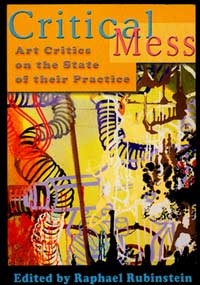March 14, 2007
Whispers in the Crowd

Via Modern Kicks, in Big Red & Shiny Issue #59, Mathew Nash reviews "Critical Mess", a book I flicked with my Amazon 1-Click and which now is queued up on my nightstand for what I expect to be a good read.
In the meantime, why not read an online review? Here's a snip:
What is left, then, is text that is not critical at all, or at least not openly and consistently so. The text that is produced in response to art is introspective, descriptive, personal and, at it?s best, offers the writer as a portal though which the work can be experienced in text and removed from the authentic experience of the work itself. ?The slip of terminology from art criticism to mere art writing in recent years is symptomatic of a growing indifference to writing?s polemic and contestative potential,? Charlesworth writes.My take: you can't maintain a critical posture without a framework to critque from in the first place. This framework is the construction of a model for recent art history, an act which has been forbidden by a core tenant of our recent era(...a.k.a. postmodern, the word which currently cannot be uttered in "intelligent" circles in our artworld): that any generalization is a violent and unjust reduction inflicted on reality. Unless we are able to schematize the arc of the past fifty years, we will be hung up on the horns of the dilemma that Nash et al are describing.As it is laid out by several writers in Critical Mess, the ?crisis? in art criticism is on several fronts. The first part of the problem is that critics cannot, or choose not, to be decisively judgmental about artwork, and opt instead for personal insights and descriptive, ?belletristic? writing. The second side of the problem lies in the audience, who do not perceive art criticism as definitive or authoritative, and may not even read it at all. The final dilemma for art critics is that the scale of the art world has grown exponentially in the past few decades, and the pluralistic and interdisciplinary nature of art denies critics firm points of reference upon which they can declare works good or bad, and instead pushes them into the role of explaining the discursive nature of contemporary art.
Further down, Nash nails how the power of publication has been radically democratized:
The very fact that Critical Mess avoids talk of artists and their audience implies that the critical structure wants to be removed from the actual day-to-day creation and conversations of work; critics, it seems, should show up at the end and approve or disapprove, declare what is right or wrong with art, and then leave until the next show. The very idea that involvement in, or engagement with, the larger art community might actually help critics and their audience is discarded as unpleasant. Only McEvilley, the ?outsider,? has any interest in stating the obvious:?If we want the rest of the cultural world to even begin to take our discourse seriously, we?ve got to demystify it from all of this insane romantic priestly power-tripping.?
In many ways, this is already happening, just not among the people who are famous for being art critics. Blogs and online journals, written by artists or those who care about art, are creating conversations that not only ?demystify? criticism but openly encourage their audience to become a part of it. Far from shouting down to the masses from a pulpit, the new form of criticism is passed in whispers among the crowd; the Critical Mess is not that the peasants are no longer begging the critic Pharisees for bread, but that they are feeding themselves and proud to do so.
Big, Red & Shiny, chock full of interesting stuff.
Posted by Dennis at March 14, 2007 11:19 AM
Leave a comment